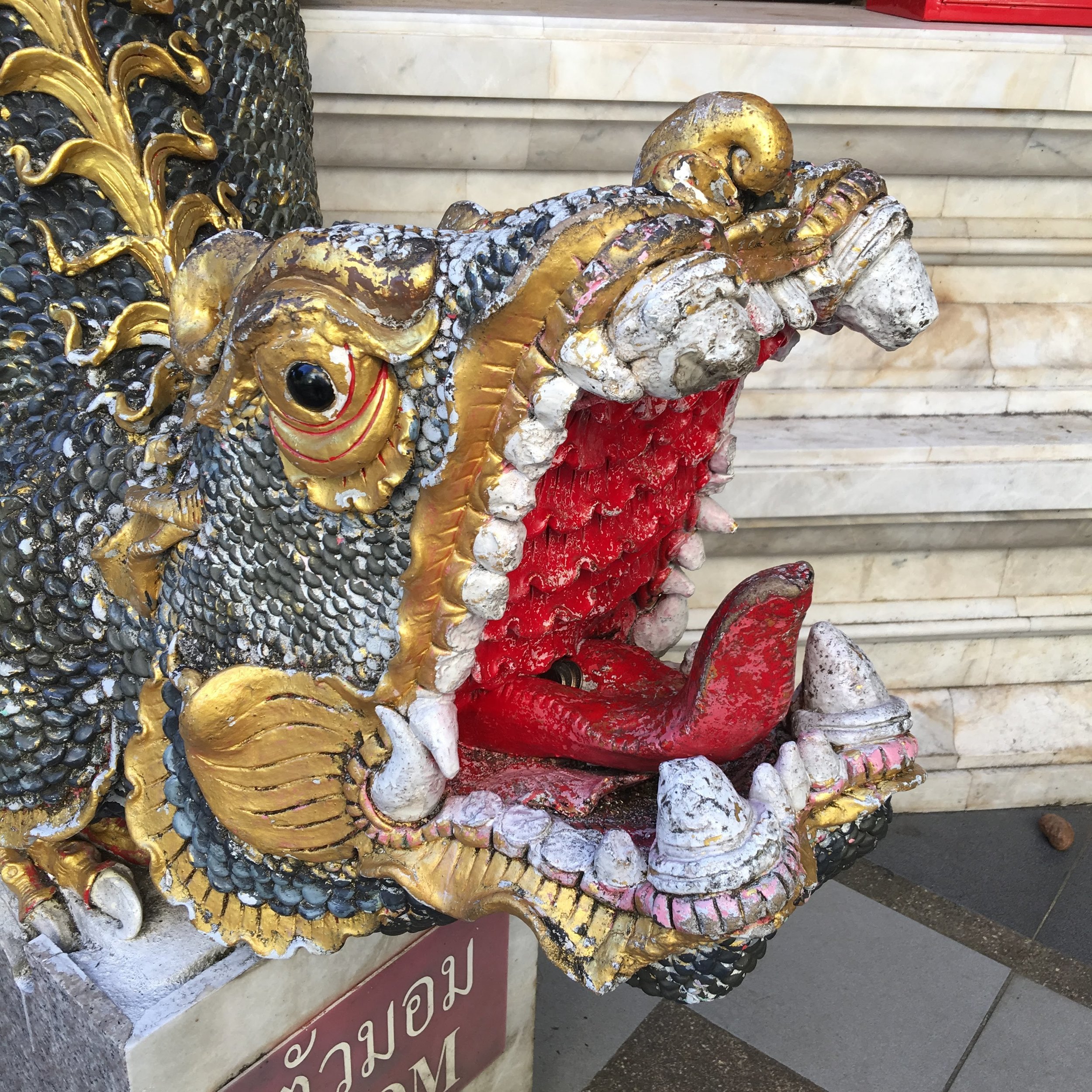Wat Phra That Doi Suthep
George and I explore many wats here in Chiang Mai. Almost all are interesting because of the back-story, architecture, Buddha images, etc. But one really stands out: Wat Phra That Doi Suthep which is considered to be one of the most sacred pilgrimage sites in Thailand. Its name describes it well. “Phra” signifies an honorific Buddha image; “That” tells us there is a relic; and “Doi Suthep” references the name of the mountain where the Wat was built, circa 1383.
Legend has it that in the 1300’s a monk named Sumanathera had a dream that directed him where to find a magical relic of a bone from the Gautama Buddha. The monk eventually presented it to Chiang Mai’s King Nu Naone who wished to build a new temple for the relic. Desiring the optimal location, the Kind placed the relic on the back of a chang samkhan (holy white elephant) which was released into the jungle. The elephant climbed up Doi Suthep, made three counterclockwise circles, trumpeted three times, then dropped dead. The king considered this an omen and ordered the construction of a temple on the site.
Wat Doi Suthep is about 9.5 miles northwest of the Old City up a steep and winding road. With my daughter Sarah and her husband, we hired a GRAB car for the morning. Even before 9am the road was pulsing with activity. We passed Songthaews (red pick-up truck taxis), tut-tuts (motorcycle-style taxis), and people walking up the steep mountain. Monk Khruba Sriwichai (“The Engineer Monk”) led construction of the paved road up the mountain jungle in 1935 as a joint effort among communities, each of whom contributed 1,300-foot sections.
At the base of the Wat, we then walked up the 306 steps with families, tourists, pilgrims, to the esplanade where we all removed our shoes before proceeding to the more sacred areas. On Visakha Bucha Day, pilgrims will camp overnight in the esplanade, to watch the sunrise and commemorate the birth of the Buddha in the morning.
Pilgrims earn merit by climbing the 306 steps guarded by giant snakes or nagas thus creating the longest naga balustrade in Thailand. The King of Nagas once protected Buddha from a terrible storm by using his cobra hood to shield Buddha and ever since the cobra has been an icon of protection. Here they protect pilgrims approaching the temple.
Atop the 52-foot tall Golden Pagoda is the crowning five-tiered umbrella that marks Chiang Mai’s freedom from 200 years of Burmese rule and its subsequent union with Siam in 1892.
The standing Buddha image with his hand upraised is in the abhāya mudrā position of fearlessness while facing adversity. He is draped with monastic robes, with the right shoulder bare, as symbol of humility (Gautama Buddha had been the powerful prince Siddhartha). The sitting Buddha images are in the Bhūmiśparṣa mudrā position - "Buddha subduing Māra" (the demon who tried to prevent him attaining enlightenment).
Wall murals tell the story of the Gautama Buddha. Above, as Prince Siddhartha, he gazes upon his sleeping wife and child before leaving on his journey to attain enlightenment. The temple bells symbolize wisdom and compassion which are the path to enlightenment. A bell also symbolizes the Buddha’s voice which can purify a holy place.
The elderly monk drew quite a crowd among the pilgrims. Thais as well as other Asian cultures highly respect the elders, not just in feeling and expressing respect but also with specific greetings and behaviors.
Buddhist pilgrims receiving blessing from the monk. In the time of Gautama Buddha, monks wore robes stitched of unwanted rag cloth, dyed with vegetable matter - here the yellow-orange color of saffron. To make merit pilgrims present monks with new robes (see the one still in the plastic wrap). At the end of the rainy season retreat for the monks (Buddha asked that monks not travel then so not to step on insects), Buddhists donate new robes for the Thod Kathina festival.
Here is a MOM - mythical guardians called Dtuwamaum who are amalgams of 8 animals: dragon eyes, sheep horn, snake tongue, crocodile teeth, fish scale & tail, elephant’s head, monkey body and bird’s legs. Of course, the human MOMs are also fierce and loving guardians.
Supporting this magnificently ornate viewing platform are these 4 massive teak pillars, carved with numerous Buddha iconography.
The golden pagoda (“chedi”) houses the holy relic. Based on Buddhist and Hindu architectural principles, the tiered and angular shape of the chedi and its tiers represent the level of heavens that one must ascend in order to achieve Nirvana as well as the hierarchy associated with a monarchy. According to Hindu mythology the 5-tiered umbrella (“chatra”) is a symbol of kingship. In Thailand the Nine-Tiered Great White Umbrella of State is considered the most sacred and ancient of the Thai royal regalia.
From a terrace at Wat Doi Suthep we have a beautiful view of Chiang Mai.









